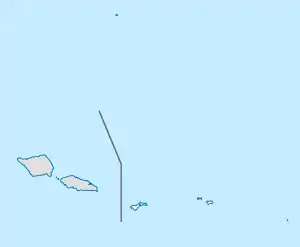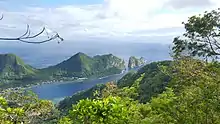Vaiʻava Strait
Vaiʻava Strait (Samoan: Vāinuʻu o Vaiʻava) is a narrow strait in Vatia, American Samoa which separates the 420-foot-high (130 m) Pola Island (Cock's Comb) from Polauta Ridge on adjacent Tutuila Island. The strait is a good example of cliffs formed by the erosional forces of waves on volcanic rock. The lands surrounding the strait are held communally. A 250-acre (100 ha) area surrounding the strait was designated a U.S. National Natural Landmark in 1972.[1] Pola-Uta is connected to the village of Vatia on Tutuila Island. Pola Tai is a 400-foot (120 m) cliff that is an important nesting area for the fua'ō (brown booby) and tava'e (white tailored tropic bird). Hunting of brown boobies, known as the A'ega o le Pola, was a tradition carried out by Vatians in the past. Pola Tai includes Matalia Point, Cockscomb Point and Polauta Ridge.[2][3]
| Vaiʻava Strait | |
|---|---|
 Vaiʻava Strait National Natural Landmark | |
.png.webp) Map of American Samoa  Vaiʻava Strait (American Samoa) | |
| Location | American Samoa |
| Nearest city | Vatia |
| Coordinates | 14°14′19″S 170°40′17″W |
| Area | 250 acres (100 ha) |
| Designated | 1972 |
| Administered by | U.S. National Park Service |
It is located on the north coast of Tutuila Island, on the northwestern side of the village of Vatia. It is a designated 250 acres (100 ha) National Natural Landmark, but also a part of the National Park of American Samoa. Erosion by the sea has sculpted deep cliffs and sea arches in the rocks of a huge volcanic plug (Pola Island). The 420 feet (130 m) cliffs and rock top are important nesting and resting areas for several seabird species.[4]
Gallery
 Vai'ava Strait, 1907
Vai'ava Strait, 1907
 Eastern point of Vatia Bay
Eastern point of Vatia Bay Polauta Ridge and Pola Island
Polauta Ridge and Pola Island
References
- "Vai'ava Strait". nps.gov. National Park Service.
- Harris, Ann G. and Esther Tuttle (2004). Geology of National Parks: Volume 2. Kendall Hunt. Page 609. ISBN 9780787299705.
- Fai’ivae, Alex Godinet (2018). Ole Manuō o Tala Tu’u Ma Fisaga o Tala Ave. Amerika Samoa Humanities Council. Page 66. ISBN 9781546229070.
- Goldin, Meryl Rose (2002). Field Guide to the Samoan Archipelago: Fish, Wildlife, and Protected Areas. Bess Press. Page 284. ISBN 9781573061117.